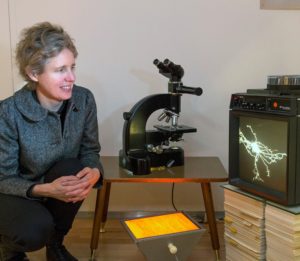
The microscope is central to science as both tool and symbol – now a new exhibition at Flinders University’s City Gallery puts the quintessential instrument of scientific enquiry into a new, provocative role.
Curated by Flinders Art Museum staff Fiona Salmon and Maddie Reece, The Microscope Project brings together works by artists Nicholas Folland, Ian Gibbins, Deb Jones, Catherine Truman, Angela Valamanesh and writer Melinda Rackham.
The original impetus for the exhibition came from recently retired Flinders neuroscientist Ian Gibbins and Catherine Truman, who had worked with Emeritus Professor Gibbins in the Department of Anatomy and Histology as an artist-in-residence.
Rather than consigning a set of decommissioned electron microscopes to the scrapheap, Professor Gibbins, who is also a poet and musician, wanted to use them as raw material for a project which would see the sophisticated scientific hardware reimagined through art.
“The idea was to look at the instruments themselves and their human dimension, rather than what was seen through them,” Professor Gibbins said.
The works respond to the microscopes by reconstructing the scientific instruments as sculpture, installation, moving image, photography and text.
The initial development of The Microscope Project took place over twelve months, using a shared warehouse space in Thebarton that was formerly a pharmaceutical distillery. In the laboratory-like setting, the components were stripped and laid out, and their artistic possibilities began to emerge.
“It was like being in an ocean of these amazing highly engineered, specialised machine parts, and gradually it dawned on me that there was a human story behind these machines – that somebody had designed them, somebody had actually constructed them and, of course, people used them. A sense of humanity began to evolve and manifest,” Catherine Truman said.
The result is a range of large and small-scale static and interactive exhibits that are at once playful and thought-provoking.
One of the most spectacular works combines 100 microscope parts with lighting to form a rotating sculptural mobile, complete with a musical backing track by Professor Gibbins.
Co-curator Fiona Salmon said that while commissioning a conceptual and original exhibition had been a “leap of faith”, engaging a group of insightful and experienced practitioners had produced an extraordinary result.
“The Microscope Project presented the Art Museum with an unparalleled opportunity to enter the hybrid space of art and science, and the exhibition brings to the public a conversation around the complex ways that we see, perceive and construct the world in which we live,” Ms Salmon said.
The Microscope Project is on display at the Flinders University City Gallery, located within the State Library on North Terrace, from July 26 to September 21.

